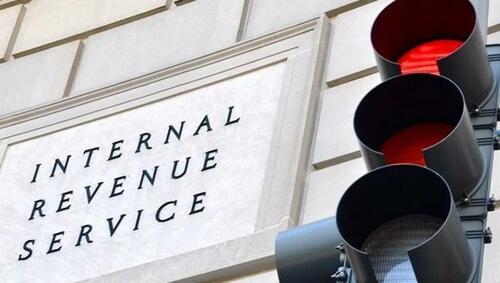IRS Bows To Pressure, Grants 2-year Reprieve On 401(K) Catch-Up Contribution Rule
Authored by Tom Ozimek via The Epoch Times (emphasis ours),
The Internal Revenue Service (IRS) has agreed to put a two-year freeze on implementation of a contentious new rule that requires catch-up contributions by higher-income participants in 401(k) and similar retirement plans to be designated as after-tax Roth contributions.
Bowing to public pressure, the IRS has agreed to provide an administrative transition period until 2026 that postpones enforcement of a new provision in the SECURE 2.0 Act that requires catch-up contributions by higher-earning retirement plan participants to be designated not as pre-tax contributions to plans like the 401(k) but as after-tax contributions to Roth IRA accounts.
The new Roth catch-up contribution rule (Section 603 of the SECURE 2.0 Act) applies to people who participate in 401(k), 403(b), or 457(b) plans and whose prior-year Social Security wages exceeded $145,000.
Also, the IRS provided additional clarification that plan participants aged 50 and older can continue to make catch-up contributions after 2023, regardless of income.
“The IRS basically has announced that they are going to interpret around the legislative text glitch that’s been discussed,” said Kelsey Mayo, Outside Director of Regulatory Affairs for the American Retirement Association, according to a note issued by the National Association of Plan Advisors.
“They’re essentially saying catch-up provisions have not been eliminated, period. That’s point No. 1,” Ms. Mayo added. “And point No. 2 is now you don’t have to make it a Roth for two years, and it can continue to be pre-tax catch-ups until 2026 regardless of income.”
The American Retirement Association was one of over 100 organizations that, in a June letter (pdf) to the House Ways and Means Committee, demanded a two-year delay in implementing the new Roth IRA catch-up rule.
Request for 2-Year Transition
The coalition letter cited an inability on the part of many signatories—to adapt their systems to ensure that catch-up contributions will be made on a Roth IRA basis for those earning more than $145,000 in the preceding year.
“Unless transition relief is granted as soon as possible, many retirement plan participants will lose the ability to make catch-up contributions at the end of this year,” the signatories wrote.
“For many of these plans, unless this requirement is delayed very quickly (i.e., this summer), their only means of compliance will be to eliminate all catch-up contributions for 2024.”
The reason is that, for the most part, the signatories lack arrangements that coordinate retirement plan recordkeeping with payroll systems (which determine who earned more than $145,000 in the prior year).
“These circumstances pose a long list of other obstacles including, for many plans, the challenges of adding a Roth feature and communicating that feature to participants, as well as special challenges for state and local governments and collectively bargained plans,” the signatories wrote.
Their request was for Congress to pass legislation to provide a two-year delay to allow employers and plan providers to adapt their systems—or for the IRS to act unilaterally and grant relief from the new catch-up contribution rule.
With its Aug. 25 announcement, the IRS has done just that.
“The administrative transition period will help taxpayers transition smoothly to the new Roth catch-up requirement and is designed to facilitate an orderly transition for compliance with that requirement,” the IRS wrote in the announcement.
American Retirement Association CEO Brian Graff said that the organization had asked for relief on the issue “and we really appreciate Treasury and the IRS understanding how challenging it would have been to comply with the mandatory Roth catch-up requirement by January 1, 2024.”
“Allowing for a two-year transition period is a big win for plan sponsors, recordkeepers and participants,” Mr. Graff added.
Traditional 401(k) accounts are funded with pre-tax earnings, and withdrawals are taxed once savers enter retirement. Roth IRA accounts, by contrast, are funded by after-tax dollars, with subsequent withdrawals being tax-free.
Other Changes Under SECURE 2.0
The SECURE 2.0 legislation introduced a number of other changes, as well.
The legislation changed the age at which people are required to start taking minimum distributions from their retirement accounts. Under the SECURE 2.0 Act, the new minimum distribution age is 73 for those who turn 72 after Dec. 31, 2022, and 75 for those who turn 74 after Dec. 31, 2033.
However, if someone is already qualified to take their first distribution by April 1, 2023, these changes won’t affect them. The act also reduced the penalty for not taking the required distribution to 25 percent from 50 percent, starting Dec. 29, 2022.
The SECURE 2.0 Act also permits employers to count qualified student loan repayments as employee contributions to retirement plans, even if the employee isn’t making regular contributions. This allows employers to match these repayments with contributions to the retirement plan.
Under the SECURE 2.0 Act, individuals can now withdraw up to $1,000 from their retirement accounts for unforeseeable and immediate personal emergency expenses. The plan administrator relies on the employee’s certification that the emergency meets the required criteria for the withdrawal.
Another change is that, starting in 2025, part-time employees will be able to participate in workplace retirement plans sooner. Previously, they had to work at least 500 hours for three consecutive years in order to be eligible; now they need to work only 500 hours for two consecutive years to qualify.
Tyler Durden
Tue, 08/29/2023 – 11:40
via ZeroHedge News https://ift.tt/3GDWzNF Tyler Durden
